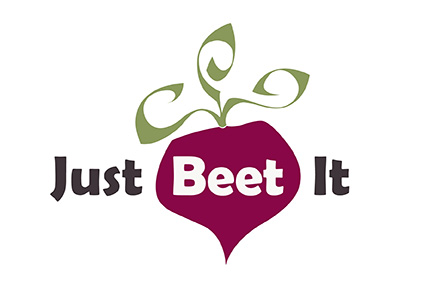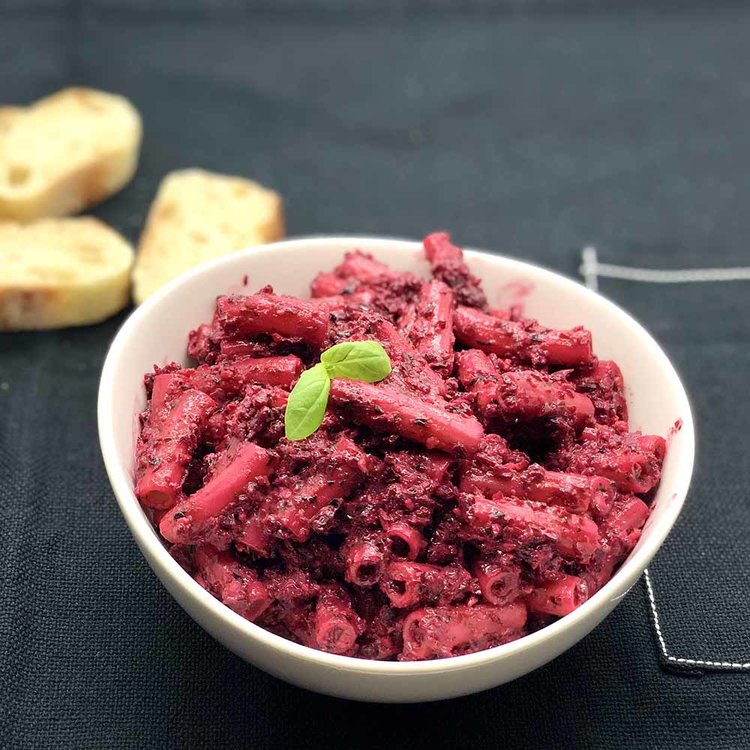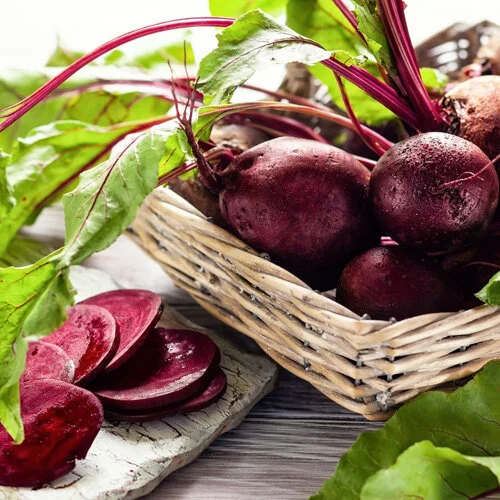Did you know that beets have been used to cure hangovers, heal dandruff, make delicious port wine, and enhance sexual performance? Yes! Even astronauts have munched on beets in space. The beet IS that cool!
Despite its astronaut-eating coolness factor, the beet is not always met with a happy "hello"! Some people passionately embrace the beet, while others retract in horror; however, Dwight Schrute, the devoted beet farmer from the hit TV series, The Office, was clearly onto something special . . . there is more than meets the eye to the quirky root vegetable.
Although we are most familiar with the red beet, there are countless varieties of beets, each with a particular flavor and nutrient profile. Beets are golden yellow, bright white, scarlet red, and "candy cane" pink and white striped. Nature's "candy" perhaps? Some beetroots are sweeter and others more "earthy" but ALL varieties offer incredible health benefits. Plus -the beet is completely edible from beetroot (the bulb) to beet stems to beet leaves.
Historically, beet leaves were consumed more than the root while the beetroot was often used for its vibrant hue (for dyes) and its medicinal properties. Over time, the beautiful beetroot has stained its way onto our tables and into our hearts. Cheers to the extraordinary beet!
10 INCREDIBLE HISTORICAL AND NUTRITIONAL BEET FACTS
1. Find Love with Beets
In beet folklore and some cultures, falling in love was considered a result of a couple eating from the same beetroot. Who knew? Eating the beautiful beet may help your heart "beet" for that special someone.
2. Beets May Cure Garlic "Breath"
Looking to eliminate garlic breath? Drink raw beet juice or eat raw beets. Consuming raw fruits and veggies, specifically beets, helps decrease the concentration of certain odors with their super powerful odor- eliminating enzymes. Look out mints and gum! There's a new breath deodorizer in town, and it is un"BEET"able!
3. Astronauts Eat Beets
In 1975, during the Apollo-Soyuz Test Project, astronauts from Apollo 18 were welcomed with beetroot soup (borscht) at zero gravity by cosmonauts from the USSR's Soyuz 19. Borscht - believed to originate from the Ukraine, is a popular soup in many Eastern and Central European countries. Beetroot is the main ingredient, and the beet is what gives the soup its vibrant blood-red color. This soup is healthy and hearty, perfect for sustaining astronauts and cosmonauts exploring the final frontier.
4. Beet Juice May Cure Hangovers
Had one too many drinks last night? Beet juice may be your cure! Beets are filled with nutritional benefits, healing and eliminating toxins from alcohol consumption. Plus beet juice keeps you hydrated with vital trace minerals, such as potassium, magnesium, and manganese to help you recover faster with necessary electrolytes. New to drinking beet juice? You don't have to drink beet juice "straight up." Beet, Apple, and Ginger Detox Smoothie and Beet, Carrot, and Kale Juice are excellent hangover cure blends of fruits and veggies.
5. The Beet is Nature's First Viagra
Used as an aphrodisiac in Roman times, the beetroot could be considered nature's first "Viagra." Drinking beet juice or consuming cooked beets may improve cardiovascular function and performance. Furthermore, the beetroot contains significant amounts of boron, which relates to the production of human sex hormones. Fun Fact 5.5: During excavations, archaeologists discovered paintings of beetroots on the walls of lupanares (brothels) in ancient towns, preserved in ash from the eruption of Mount Vesuvius in 79 AD.
6. Aristotle was a Beet Enthusiast
In Greek history, Aristotle (384-322 BC), ancient Greek philosopher and scientist, left detailed descriptions about beets, as did his students, noting the depth of red color. Aristotle's views on physical science have profoundly shaped scholarly views, so of course, someone as educated as Aristotle would certainly understand and admire the benefits of beets!
7. Beets Make Delicious Wine
Vegetable wine? Yes! Beetroot can be made into a wine that tastes similar to port. The red beet is high in natural sugar with a sweet earthy flavor, creating a deliciously sweet dessert wine. The extraordinarily humble beetroot also makes an incredible Beet Simple Syrup, the perfect addition to your favorite cocktails/mocktails. A Pickled-Beet Dirty Martini may turn you into a beet enthusiast.
8. Heal Dandruff with Beets
It is believed that nightly scalp massages with the water (cooled down) left behind from boiled beets is an effective cure for dandruff. Additionally, Since the 16th century, beet juice has been used as a natural red dye to naturally stain cheeks and lips a beautiful rosy glow. In 19th century England, the Victorians used beets to dye their hair. Using beet juice to dye hair is still a natural way to add a "red" shine to your hair.
9. Assyrian Beets: an Ancient World Wonder
An Assyrian text (800 BC) describes beets growing in the Hanging Gardens of Babylon, one of the wonders of the ancient world. Although historically, the beetroot (bulb portion) was used more medicinally than for consumption, and the beet greens (leaves) were consumed more than the root, it is evident that historically the beet has been admired for its extraordinary benefits and beauty!
10. Determine Healthy Stomach Acid with Beets
Beets can be used to test levels of stomach acid. Drinking beet juice and beet consumption may give your urine and bowel movements a red color. Do not be alarmed! This condition called Beeturia is not considered harmful. Eating beets and/or drinking beet juice is a great way to determine healthy stomach acid levels; healthy stomach levels should be balanced, neither TOO low or TOO acidic. Learn more about the exciting world of gastric acidity in this article: The Evolution of Stomach Acidity and Its Relevance to the Human Microbiome published by the US National Library of Medicine and National Institute of Health.
(If you suffer from an iron deficiency, iron excess, or iron metabolism issues, you may be more likely to experience Beeturia. Consult your physician with questions and concerns).
BEET RECIPES
Fall "More" in Love with the Beet!
Resources
Apicius. (Vehling, Joseph D., Trans., and Ed.). (1977). Cookery and Dining in Imperial Rome: A Bibliography, Critical Review and Translation of the Ancient Book Known as Apicius de re Coquinaria. New York: Dover Publications (original work published 1936).
Beasley, DeAnna E. et al. (2015). The Evolution of Stomach Acidity and its Relevance to the Human Microbiome. Retrieved from https://www.ncbi.nlm.nih.gov/pmc/articles/PMC4519257/.
Bender, A.E. and D.A. Bender. (1995). Oxford Dictionary of Food and Nutrition. Oxford, UK: Oxford University Press.
Betalains, Phase II Enzyme-Inducing Components From Red Beetroot(Beta vulgaris.) Extracts. (2014). Lawrence Erlbaum Asociates, Inc.
Davidson, Alan. (1999). The Oxford Companion to Food. New York: Oxford University Press Inc.
Herbst, Sharon Tyler and Ron Herbst. (2013). The New Food Lover’s Companion. Barron’s Educational Series, New York.
Montanari, Massimo, Ed. (2012). A Cultural History of Food in the Medieval Age. Berg Publishing, London, UK.
Morgan, Diane. (2012). Roots: The Definitive Compendium with more than 225 Recipes. San Francisco, CA: Chronicle Books LLC.
Nottingham, Stephen. (2004). Beetroot. Retrieved from http://www.stephennottingham.co.uk/beetroot6.htm.
Robinson, Jo. (2013). Eating on the Wild Side. New York: Little, Brown and Company.
Splittstoesser, W. E. (2014). Beet. In Public Libraries. Retrieved from http://www.worldbookonline.com/pl/infofinder/article?id=ar052980.
Sugar Beet White Sugar. (2009). Food and Agriculture Organization of the United States, FAO Investment Centre Division. Web, Sept. 2014
YOU MAY ALSO LIKE






















